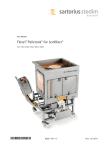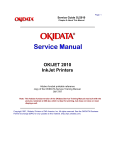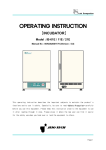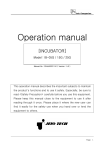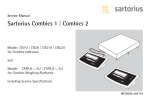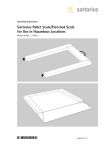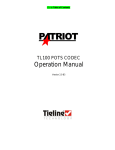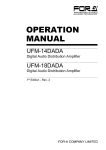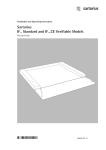Download USER MANUAL LEWA ISO 5 Bottling Station 021
Transcript
Learning to Use the LEWA ISO5 Bulk Bottling Station Safety Installation Key Features Operation Maintenance and Cleaning Original Instructions 2 Learning to Use the LEWA ISO5 Bulk Bottling Station About LEWA LEWA GmbH, founded in 1952 headquartered in Leonberg, Germany, has developed over just a few decades into an international group, and its position in the world market was further strengthened by its integration into the Japanese NIKKISO Co. Ltd. in 2009. As a research and products based corporation, LEWA-Nikkiso develops technologies and engineers solutions for a wide variety of its customers' applications. The company’s products are used in critical, demanding industries such as the life sciences, nuclear, medical, oil and gas, plastics, aeronautics, food and beverage and personal care industries. The LEWA division currently has approximately 750 employees and has 16 subsidiaries worldwide as well as representatives and sales offices in over 80 countries. LEWA Process Technologies, Inc. (formerly called IPT and now called LPT) was founded in 2000 and was acquired in 2013 by LEWA-Nikkiso. LPT is a design-build engineering and manufacturing company based in Devens, Massachusetts, USA, that provides products and services to the pharmaceutical, biotechnology, and high purity process industries. © 2015 LEWA. All rights reserved. Information in this user guide is subject to change without notice. Error! Reference source not found. 3 Contents About This User Guide 4 Welcome to the User Guide ................................................................................................................... 4 Important Documents to Read ............................................................................................................... 4 Where to Get Help ................................................................................................................................. 5 Typographic Conventions ....................................................................................................................... 6 Working Safely 7 Important Safety Information You Must Read First ................................................................................ 7 Warnings and Cautions .......................................................................................................................... 7 Unpacking and Installation 11 Package Contents ................................................................................................................................ 11 Optional Equipment ............................................................................................................................. 11 Installation ........................................................................................................................................... 11 Storing the Bulk Bottling station .......................................................................................................... 15 Moving the Bulk Bottling station .......................................................................................................... 15 Overview of the Bulk Bottling station 16 Description of the Bulk Bottling station ................................................................................................ 16 Main Features ...................................................................................................................................... 16 Additional Features and Controls ......................................................................................................... 21 Using the Bottling Station 25 Key Process Steps ................................................................................................................................. 25 Recovery from an Emergency Stop ....................................................................................................... 28 Maintenance and Troubleshooting 29 Maintenance Schedule ......................................................................................................................... 29 Maintenance Procedures ...................................................................................................................... 30 Troubleshooting ................................................................................................................................... 31 Recommended Spare Parts................................................................................................................... 32 Where to Purchase Replacement Parts ................................................................................................. 33 Specifications ....................................................................................................................................... 34 4 Learning to Use the LEWA ISO5 Bulk Bottling Station About This User Guide Welcome to the User Guide This user guide describes how to use the LEWA ISO5 Bulk Bottling Station. To use the bulk bottling station safely, read this guide BEFORE installing and operating it. Keep this guide near the bulk bottling station and make it accessible to new users. Intended Audience We wrote this user guide for: (1) operators, (2) quality control personnel, and (3) clean room supervisors who have at least five years of experience in operating biopharma process equipment in a clean room environment. If you are new to working with high purity and biopharm processing equipment, obtain training before using the bottling station. If you do not understand any instruction in this guide, contact LEWA for assistance before proceeding. LEWA can provide training in the operation and maintenance of the bottling station. The instructions in this user guide are not a substitute for the observance of your companyspecific regulations. Important Documents to Read Your bottling station includes the OEM documents listed below (or the most recent version of these documents). The OEM documents include operating, safety, and maintenance information not included in this user guide. Hence, you must read these OEM manuals BEFORE using the bottling station to fully understand the safe use and maintenance of the third party equipment. ABB user guide for the single-phase current monitoring relays ATI user guide for the air operated aerosol generators Banner STB user guide for the optical touch buttons GermFree user guide for vertical laminar flow hood Phoenix contact user guide Sartorius installation guide Sartorius Combics indicators user guide Sartorius weighing platform user guide Sensocon differential pressure controller user guide Error! Reference source not found. Where to Get Help To help ensure trouble-free operation of your bottling station, LEWA provides you with the following resources. Support Services and Training Our customer support teams can answer your technical questions and provide replacement parts. Call the customer support teams at the numbers below. LEWA has the capability to train users in bottling station operation, safety, and maintenance. Contact us to learn more about training programs. Contact Information LEWA® 8 Charlestown St. Devens MA 01434 Phone: +1 978–487–1100 Fax: +1 978–487–1121 LEWA-Nikkiso America, Inc. 132 Hopping Brook Road Holliston, MA 01746 Phone: +1 508–429–7403 Fax: +1 508–429–8615 [email protected] Headquarters LEWA GmbH Ulmer Str.10 71229 Leonberg Germany Phone: +49 7152 14–0 Fax: +49 7152 14–1303 [email protected] NIKKISO CO. LTD Ebisu Garden Place Tower, 22nd Floor 20-3, Ebisu 4-Chome, Shibuya-ku 150–6022 Tokyo Phone: +81 3 3443–3711 Fax: +81 3 3473–4963 LEWA Web Site For addition information about our products and services, visit www.lewa-inc.com Expert Advice This user guide includes advice from biopharm processing experts to help you use your bottling station efficiently and effectively. Expert advice is highlighted using a light bulb icon. EXPERT ADVICE—Presents knowledge and ideas to help you use your biopharm processing bottling station effectively. 5 6 Learning to Use the LEWA ISO5 Bulk Bottling Station Typographic Conventions References to software commands, windows, menus, and fields are indicated by bold text. For example, “Press the Weigh button on the scale’s control panel.” Likewise, references to specific hardware components and settings are indicated by bold text. For example, “Turn the Motor switch to the Off position.” Error! Reference source not found. Working Safely Important Safety Information You Must Read First Read the safety information in this section before installing, operating, or servicing the bottling station. Perform a risk assessment for the area and process in which you install the bottling station to ensure the use of the bottling station does not change the classification of the area. To provide quick access for disconnecting power, do not block access to the receptacle where the power cord is plugged in. Other Key Safety Points to Remember The Emergency Stop button stops the bottling station’s moving parts and stops equipment plugged into the electrical receptacles on the station. The Emergency Stop button does not disconnect main power from the main electrical cabinet. Do not insert fingers or hands into fans or other moving parts. Regulatory compliance is the responsibility of the user and all claims to meet bio-burden, particulate or air flow suitability must be verified by the user under the specific operating conditions at the user’s installation. Warnings and Cautions Flags Notify You of Important Warnings and Cautions A warning flag indicates the potential for injury or death if you do not follow the prescribed preventative measures. A caution flag indicates the potential for machine or product damage if you do not follow the prescribed preventative measures. Warning and precaution information is highlighted in the user guide using these symbols: WARNING—A warning flag identifies a risk for personal injury or death and provides information to prevent injury or death. CAUTION—A caution flag identifies a risk for equipment or product damage and provides information to prevent equipment or product damage. 7 8 Learning to Use the LEWA ISO5 Bulk Bottling Station Warnings and Cautions WARNING—See warning statements below. If unqualified personnel open and work inside electrical power cabinets, injury or death can result from electrical shock. To prevent injury or death by electrical shock, only qualified and trained maintenance personnel—using lockout/tagout procedures, should open the bottling station cabinet doors and work in the cabinets. Opening the electrical cabinet doors without completing your company’s lockout/tagout process, can result in death or injury due to electrical shock. To prevent death or injury, do not open electrical cabinet doors without first completing your company’s lockout/tagout procedure. Using the bottling station in a potentially explosive atmosphere or for processing flammable fluids can result in fire or explosion and injury or death. To prevent a fire or explosion, do not use the bottling station in a potentially explosive environment or for processing flammable fluids. If untrained personnel install, operate, or service the bottling station, they can be injured. To prevent injury, ensure installation, maintenance, and operation functions are completed by qualified and trained personnel. Using the bottling station when it is damaged can led to personal injury due to equipment malfunction. To prevent injury, do not use the bottling station if it is damaged by dropping or water egress. Using or producing hazardous substances and biological agents without proper personal protection can result in exposure leading to injury and death. To prevent injury or death from exposure to hazardous substances and biological agents, wear the proper personnel protective equipment as outlined by your company’s safety program. If the bottling station is not connected to a protective earth, personnel can be electrocuted. To prevent electrocution, always connect the bottling station to a protective earth. Using a forklift of insufficient capacity can result in unexpected dropping of the bottling station, resulting in injury or death. To prevent injury or death due to unexpected dropping, use a forklift rated to lift the weight of the bottling station. If you do not lift the bottling station using the lift instructions, the bottling station can accidently tip over leading to death or injury. To prevent tipping over and the resulting potential for injury, ensure you lift the bottling station using the lift instructions including in this user guide. Error! Reference source not found. Careless moving of the heavy bottling station can result in workers being squeezed or crushed against other equipment or walls. To prevent squeezing and crushing injury, move the equipment slowly and ensure workers do not position themselves where injury could result. Do not allow the wheels of the bottling station to run off of ramps. Use a sufficient number of movers to maintain control of the bottling station, particularly when on ramps. LEWA designed the bottling station to be mobile. To prevent tipping during transportation, you must remove the HEPA Filter and fan unit before moving the unit. To prevent injury from tipping during transportation, also ensure the wheel brakes are off, the power cord is unplugged and stored to prevent contact with the wheels, and all doors are closed. Intended Use of the bottling station—LEWA designed the bottling station to provide a clean environment for bulk filling of pharmaceuticals. If you use the bottling station in a manner not specified by LEWA in this user guide, you may be exposed to hazards leading to personal injury or equipment damage. The bottling station is not intended for use in clinical procedures or for diagnostic procedures. It is not designed for steam-in-place cleaning or other cleaning methods except those described in this user guide. CAUTION—See caution statements below. Using process or cleaning fluids that are incompatible with the bottling station’s stainless steel and polycarbonate can damage the bottling station. Use the bottling station only in an indoor environment with an ambient atmosphere meeting the operating specifications. If the packing crate was exposed to pesticides as regulated by some companies, handle and recycle the packing crates according to local recommendations for pesticide-treated wood. Maintenance Safety Notes Before performing maintenance or decommissioning, complete the preparatory steps outlined in the “Making the Bulk Bottling Station Safe for Maintenance” section. Only personnel trained by LEWA should perform service, installation, and maintenance inside the bottling station electrical cabinets. 9 10 Learning to Use the LEWA ISO5 Bulk Bottling Station To ensure safe and proper operation, use accessories and replacement parts that are approved or supplied by LEWA. Decontaminate the bottling station before performing service and maintenance. Do not climb on the bottling station. Labels Located on Bulk Bottling station Your bottling station includes safety labels to inform you of important safety information (Figure 1). You must comply with all machine-mounted warnings and instruction plates. Figure 1. Machine mounted warning labels Important information—indicates important safety or user information is available in the user guide. Electrical safety label—indicates that high voltage electrical power is present. ADD OTHER LABELS TBD Lift from this end? Personnel Protective Equipment Before operating the bottling station, wear the personal protective equipment required by your company’s safety program for operating biopharm processing bottling stations, including equipment to prevent exposure to process fluids. If not required by your company’s safety program, LEWA mandates that operators should always wear safety glasses at a minimum to prevent injury from contact with hazards process fluids and other hazards. Error! Reference source not found. Unpacking and Installation Package Contents The following items are included with your shipment: Filling table This user guide OEM documentation for third-party components Spare parts or optional components as specified in your sales agreement Optional Equipment If needed, LEWA sells peristaltic pumps that are well matched to the bottling station operation. Installation The following steps should be completed by qualified mechanics and electricians experienced in the installation of commercial processing equipment. The main installation steps include: A—Checking Floor Requirements .............................................................................................. 11 B—Unpacking and Assembling the Bulk Bottling Station .......................................................... 11 C—Install Pumps and Accessories.............................................................................................. 15 D—Connecting Electrical Power ................................................................................................ 15 A—Checking Floor Requirements The floor must be level. The floor must be capable of supporting 700 pounds (318 kilograms). B—Unpacking and Assembling the Bulk Bottling Station Personnel trained in moving heavy equipment should follow these steps to unpack, assemble, and transport the bottling station to your clean room. Typical Shipping Arrangement The bulk bottling station is normally shipped in several containers: Container 1—Bottling station Container 2—HEPA filter cabinet Container 3—Spacer Container 4—Lighting cabinet Container 5—Remote balance displays, locating fingers, filling arms 11 12 Learning to Use the LEWA ISO5 Bulk Bottling Station Unpack the Components Follow these steps to unpack the components: 1 Uncrate the bottling station and inspect it for possible shipping damage. 2 Remove the bottling station from the crate base using a fork lift. NOTE—Install fork extensions on the forks. Direct the forks under the frame rails on the narrow side of the bottling station. Spread the forks as wide as possible. The fork lift must be rated to lift 2,000 pounds (910 kilograms). NOTE—Do not install the HEPA filter until you transport the bottling station to its operating location. 3 Using a fork lift, transport the bottling station to just outside the clean room. 4 Remove the protective tape from the wheels. 5 Unlock the wheels by lifting up on the locking levers. 6 Using a sufficient number of people, roll the bottling station into the clean room. 7 Lock the wheels and level the bottling station using the leveling feature of the wheels. 8 Move the spacer in its packaging to just outside the clean room. Unpack the spacer and place it on top of the bottling station. 9 Keeping it in a vertical position, transport the HEPA filter cabinet container to just outside the clean room and remove the HEPA filter from the container. 10 Place the HEPA filter on top of the spacer. 11 Move the light cabinet in its packaging to just outside the clean room. Unpack the light cabinet and install it on the bottling station following these steps (Figure 2): a. Attach the light-cabinet bracket to the back of the of the HEPA filter cabinet, aligning the holes in the bracket with the studs in the HEPA cabinet filter cabinet. b. Install the supplied lock washers and nuts on the top stud to hold the bracket in place. c. With assistants, lift the light cabinet into position, aligning the holes in the light cabinet mounting flanges with the studs on the light bracket. d. Install the supplied lock washers and nuts on the bottom two studs on each light cabinet mounting flange. e. Plug the yellow cable from the light cabinet into the receptacle on the HEPA cabinet. f. Plug the yellow cable from the pressure differential switch into the receptacle on the HEPA filter cabinet. Error! Reference source not found. 12 Unpack the container with the remote balance displays, locating fingers, and the filling arms. 13 Slide the remote balance displays into the display mounts on the back wall of the bottling station and tighten the thumbscrews to hold the displays in place (Figure 3). Connect the communication cables to the remote balance displays. 14 Slide the positioning rods of the locating fingers into the mounting blocks on the table and tighten the locking thumbscrews to hold them in place (Figure 4). 15 Slide the filling arms onto the filling arm mounting bracket and tighten the locking screws (Figure 5). Figure 2. Installing the light cabinet Mounting stud Light bracket HEPA filter cabinet Mounting stud Light cabinet Light cabinet mounting flange Mounting stud 13 14 Learning to Use the LEWA ISO5 Bulk Bottling Station Figure 3. Installing the remote balance display (back view) Communication cable connector Remote balance display Display mount and locking thumbscrew Figure 4. Installing the locating fingers Locking thumbscrews Mounting block Positioning rod Locating fingers Figure 5. Installing filling arms Filling arm mounting bracket Locking thumbscrews Left side filling arm Error! Reference source not found. C—Install Pumps and Accessories 1 Place a pump on each of the lower shelves. 2 Plug the pumps’ electrical cables into the electrical receptacles underneath the table next to the control panel. NOTE—You must plug you pumps into the supplied electrical receptacles in the bottling station so that the E-Stop will shut down all equipment when it is pressed. 3 Set up you pumps. Connect tubing from your product supply reservoir to the pump inlet and from the pump outlet to your bulk fill equipment inside the bottling station. D—Connecting Electrical Power 1 Connect the bottling station’s three-prong power cable plug from the light cabinet into an appropriately-rated power source (120 volt, 60 Hz, single phase). Storing the Bulk Bottling station To store the bottling station between runs, thoroughly clean it following your manufacturing and quality control cleaning procedures. Moving the Bulk Bottling station Follow these steps to move the bottling station: 1 2 3 4 5 6 7 8 Remove your process equipment from the bottling station. Disconnect the power cord and tie up and out of the way of the wheels. Clean any spills on the equipment. Remove the HEPA unit and spacer. Maintain the HEPA filter cabinet in an upright position until you reinstall it. Unlock the wheels. Use a sufficient number of people to roll the bottling station safely to its new location. Lock the wheels. Reinstall the HEPA filter cabinet 15 16 Learning to Use the LEWA ISO5 Bulk Bottling Station Overview of the Bulk Bottling station Description of the Bulk Bottling station Features The LEWA ISO5 Bulk Bottling station is an advanced biopharm processing bottling station that provides a low particulate and low bio-burden environment throughout the bulk bottling process for pharmaceuticals. Specific benefits include: Complete bulk fills in an isolated, positive pressure, HEPA high purity environment Semi-automate the filling process and fill from the bottom Increase filling consistency and repeatability Complete two bulk fills simultaneously if desired The LEWA Bulk Liquid Filling station achieves high purity standards through the filling process by minimizing operator involvement, delivering 100% first pass positive HEPA filtered air flow, providing an isolated filling environment and smoothly filling containers from the bottom up. The filling operation is precisely controlled using an automated fill arm and scale system. A free-standing vertical laminar air flow hood isolates the filling the environment from the clean room and the operator, assuring a higher level of purity during product transfer. Overview of Operation The operator loads empty bottles inside the HEPA-filtered, LEWA Bulk Bottling Station, uncaps a single bottle, and places it on the scale to determine initial weight. The single bottle is secured to the locating fingers directly underneath the purge or fill combo nozzle. Following an air purge, the automated filling arm fills the bottle with product to a pre-specified weight. Filling is performed from the bottom up to minimize foaming and air entrainment, and increase the quality of the product transfer. You pre-set the fill arm movement parameters to the dip tube and bottle height. At the completion of the filling operation, the operator removes the bottle, caps it, and prepares it for storage or the next step in the manufacturing process. Machinery Designation You can find this label on your biopharm processing bottling station: Main Features Error! Reference source not found. Main Features on the Front Side The front side of the bottling station includes these features (Figure 6): Font doors—The front doors include a small left door and a larger right door that open outward. Two thumbscrew-locks are used to lock the doors together when then are closed. Differential pressure switch—The differential pressure switch measures the difference in pressure between the inside and outside of the bottling station. If for any reason, the positive pressure inside the station falls below an acceptable level, the differential pressure switch triggers an audible alarm and the red light on the switch flashes to warn you of a problem. Control panel for Sartorius balance—This control panel enables you to setup, operate, and monitor the performance of the Sartorius balance. There are two Sartorius control panels: one for each balance included with the bottling station. Sliding setup door—Each side of the bottling station includes a sliding setup door. The doors slide upwards and lock into place. To lower a door, press the releases on each side of the door and lower the door into its lowered position. The sliding setup doors allow assistants to access the containers and apparatus in the bottling station during setup and operation. Openings in the doors at the bottom enable short and convenient routing of tubing from your process. Emergency Stop button—Pressing the Emergency Stop button stops all moving parts. If your pumps are plugged into the electrical receptacles on the bottling station, the pumps also stop when the Emergency Stop button is pressed. For this reason, you should use the electrical receptacle on the bottling station for powering your pumps feeding the station. Lower stationary shelves—The lower shelves provide support for the pumps. The shelves are removable. Locking Wheels—The locking wheels provide the means for moving and leveling the bottling station. Pressing down the foot lock locks the wheels in place. The wheel studs are threaded into the bottom of the bottling station legs. You can adjust the height of each leg using the threaded rods and locking nuts. 17 18 Learning to Use the LEWA ISO5 Bulk Bottling Station Figure 6. Features located on the front side of the bottling station Front door locks Left side front door Right side front door Differential pressure switch Control panel for Sartorius for balance Sliding setup door Emergency stop button Lower stationary shelves (removable) Lift from this end Locking wheel Error! Reference source not found. 19 Main Features Inside the Bottling Station The inside of the bottling station includes these features in duplicate (Figure 7): Automated fill arms—The user-activated automated fill arms are programmed to lower the filling nozzle to the bottom of the fill container, and then raise the filling nozzle as the container is being filled. The fill arms also support the customer supplied process equipment. Remote balance display—This remote balance display displays the weight measurements from the balance and is in easy view for the operator Sartorius balance—The Sartorius balance hardware is mounted flush with the work table. You place your container to be filled on the balance platen for tarring and filling. Locating fingers—The locating fingers enable you to position the containers you are filling in the center of the balance platen. The locating fingers are adjustable to accommodate difference size containers. and filling. Sliding loading shelf—The sliding loading shelf slides out to enable convenient loading of containers by assistants without the assistants having to reach into the bottling station. Figure 7. Features inside the bottling station Automated fill arms Remote balance display Sliding loading shelf Locating fingers Sartorius balance 20 Learning to Use the LEWA ISO5 Bulk Bottling Station Main Features on the Back Side The back side of the bottling station includes these features (Figure 8): HEPA filter cabinet—The HEPA filter cabinet includes the HEPA filter and five blowers that blow air through the HELP filters and into the bottling station to maintain positive pressure in the bottling station. Spacer—Increases interior vertical space in the bottling station. Removing the HEPA filter cabinet and spacer enables passage through most doorways. Light cabinet—The light cabinets houses the light that illuminates the working area. Electrical and control cabinet—This cabinet encloses the servo motor that drives the arms and also includes the controls for setting the up and down speed of the filling arms. Figure 8. Features located on the backside of the bottling station HEPA filter cabinet with blowers Spacer (use is optional) Light cabinet Electrical and control cabinet including servo motor for lifting and lowering the filling arms Error! Reference source not found. Additional Features and Controls This section describes the following features and controls: Main Electrical Panel .................................................................................................................. 21 Differential Pressure Switch and Alarm...................................................................................... 23 Sartorius Balance ....................................................................................................................... 24 Main Electrical Panel Cabinet Exterior The outside of the electrical panel includes two lock on each of the two doors to prevent unauthorized access. Use the supplied keys to open the locks and access the electrical equipment. Issue the cabinet keys only to personnel who are qualified to work with electrical and process control equipment. Cabinet Interior The electrical cabinet includes the servo motor that raises and lowers the filling arms. The cabinet also includes the controls that set the fill arms’ low position, high position, rise speed, and fall speed (Figure 9). An interlock switch on the left cabinet door will stop the operation of the bottling station if the left door is opened. The use of the filling arm controls is described on page 25. 21 22 Learning to Use the LEWA ISO5 Bulk Bottling Station Figure 9. Key components inside the electrical panel Solenoid motor that raises and lowers filling arms Three position knob determines how fast the fill arms will rise during filling. Door interlock switch Two position switch determines how fast the fill arms will move when being lowered. Filling parameter setup controls inside electrical cabinet Error! Reference source not found. Differential Pressure Switch and Alarms Low Pressure Alarm If the differential pressure between the table interior and ambient pressure falls too low, the differential pressure switch will illuminate the red warning light and sound an audible alarm (Figure 10). Blower Current Alarm Each blower includes a current sensor. If current to the blower is not flowing, the sensor will trigger the red warning light and an audible alarm will sound. Figure 10. Differential pressure switch Red warning light 23 24 Learning to Use the LEWA ISO5 Bulk Bottling Station Sartorius Balance Each of the two Sartorius balance systems consists of an operator control panel, a balance, and a remote display located on the back panel of the bottling station (Figure 11). Consult the Sartorius user guide for operating and safe use information. Figure 11. Sartorius Balance control panel Error! Reference source not found. Using the Bottling Station Key Process Steps The key steps in using the bottling station include these: A—Starting the Bottling Station ................................................................................................ 25 B—Setting the Filling Arm Position and Speed (Pre-Processing) ................................................ 25 C—Setting up Your Processing Equipment for Processing ......................................................... 26 D—Completing a Fill .................................................................................................................. 27 E—Shutting the System Down ................................................................................................... 28 A—Starting the Bottling Station To start the bottling station, move the Light On/Off switch and the Blower On/Off switch to the On position. B—Setting the Filling Arm Position and Speed (Pre-Processing) Follow the steps below to set the filling arm position and rise speed: 1 Lower the filling arms to the default low position by simultaneously placing and holding your fingers in the Enable and Down switches. (You must trigger these switches simultaneously within 0.5 second of each other.) The filling nozzle will move downward and stop when the low-position limit switch is triggered. 2 Place your bottle on the balance and setup up your fill nozzle the way it will be positioned during processing. 3 Have an assistant support the filling arms and loosen the clamp holding the filling arm support bar to the up/down positioning arm. 4 Adjust the position of the filling arms so the tip of the filling nozzle is near the bottom of the bottle. 5 Tighten the clamp holding the fill arm support bar to the up/down position arm. WARNING—The following steps require operating the fill station with the electrical cabinet door in an open position. If unqualified personnel work in the electrical cabinet with the doors open, they can be electrocuted. To prevent electrocution, only qualified personnel should work in the electrical cabinet. 25 26 Learning to Use the LEWA ISO5 Bulk Bottling Station 6 Adjust the rise time using water as follows: a. Use your product supply pump’s footswitch switch to start filling the bottle with water. At the same time, simultaneously place and hold your fingers in the Enable and Up switches. Water begins to flow into the bottle and the fill arm rises during the filling process. b. If the fill nozzle rises to fast or to slow, you can either adjust the fill rate using your pump, or you can use the rise speed control knob to adjust the rise speed of the filling arm (Figure 12). Move the knob to one of the three speed positions and repeat step 1. c. Continue to adjust the pump speed or filling arm rise speed until you achieve the desired results. 7 You can adjust the speed at which the filling arms are lowered my using the twoposition speed switch located in the electrical cabinet. Figure 12. Filling arm position and speed controls Three position knob determines how fast the fill arms will rise during filling. Two position switch determines how fast the fill arms will move when being lowered. C—Setting up Your Processing Equipment for Processing Setup your processing equipment including pumps, tubing, filters and fill nozzles to support your campaign. You can mount your pumps on the stationary shelves. Mount filters and fill nozzles securely on the filling arms. Use the opening in the side doors to route tubing from your pumps to your processing equipment on the filling arms. Error! Reference source not found. D—Completing a Fill These are the general steps to complete a fill operation: 1 Position yourself at the bottling station and place your arms in the hood. 2 An assistant slides out the loading shelf, places the bottle to be filled on the shelf, and slides the shelf into the bottling station. 3 Slide the bottle from the shelf onto the balance in the table. 4 Tare the balance. 5 Remove the cap from the bottle and keep it in the bottling station. 6 Loosen the thumbscrews on the locating fingers and position the bottle so that the filling nozzle is directly above the mouth of the bottle. 7 Move the locating fingers against the bottle and tighten the locating fingers in place using the thumbscrews. 8 Simultaneously place and hold your fingers in the Enable and Down switches. (You must trigger these switches simultaneously within 0.5 second of each other.) The filling nozzle will move downward and stop at the predetermined height. 9 Use your product supply pump’s footswitch switch to start filling the bottle. At the same time, simultaneously place and hold your fingers in the Enable and Up switches. Your product begins to flow into the bottle and the fill arms rise during the filling process. 10 When the proper volume or weight of the product is in the bottle, stop the pump and remove your fingers from the Enable and Up switches. Stop the product supply pump when the correct volume or weight of the product has been transferred into the fill bottle. 11 Then simultaneously place and hold the Enable and Up switches again to raise the fill nozzle out of the bottle. 12 Cap the bottle and weight it. 13 Slide the bottle from the balance to the loading shelf. 14 An assistance slides the loading shelf out and retrieves the filled bottle. 27 28 Learning to Use the LEWA ISO5 Bulk Bottling Station E—Shutting the System Down Follow these steps to shut the system down: 1 Finish filling operations and remove all processing equipment and containers from the bottling station. 2 Power down the pumps using the pump controls. 3 Move the Fan and Lights on/off switches to the Off position. Recovery from an Emergency Stop To stop a run due to an emergency or malfunction, press the Emergency Stop button located on the operator control panel. This stops all moving equipment and cuts high voltage power to the bottling station. It does not cut mains power to the electrical control panel. To restart the machine, resolve the emergency situation. Resolve and clear all alarms and warning messages. Twist and pull out the Emergency Stop button. Press reset button. Then press resume to restart run. Error! Reference source not found. 29 Maintenance and Troubleshooting Maintenance Schedule The maintenance schedule represents a starting point of best practices as observed by LEWA. The schedule is not, however, a substitute for experience with the bottling station in a production environment. As run time and experience are accumulated, adjust the maintenance requirements and schedule to meet the needs of the bottling station. To ensure optimum performance and to maintain your warranty benefits, complete maintenance on the bottling station according to the maintenance schedule (Table 1). Table 1. Maintenance schedule Maintenance Requirement Daily Weekly Monthly Annually Bottling Station 3 to 5 years or as your company SOPs dictate HEPA filter change out Check wiring external to the electrical cabinets for damage Cleaning (after every run) Sartorius Balance System See the Sartorius Balance user guide 30 Learning to Use the LEWA ISO5 Bulk Bottling Station Maintenance Procedures Making the Bulk Bottling Station Safe for Maintenance Before performing adjustments and maintenance on the bottling station, you must make the bottling station safe by following these steps: 1 Finish filling operations and remove all processing equipment and containers from the bottling station. 2 Power down the pumps using the pump controls. 3 Move the Blower On/Off switch and Light On/Off switch to the Off position. 4 Unplug the power cord from its power supply and lock out the power cord following your facility’s lockout/tagout procedures. Cleaning Bulk Bottling station Customer-supplied processing equipment should be cleaned according to you facility’s regulatory and quality standard operating procedures. Clean the bottling station’s glass and stainless steel components using alcohol or a cleaner specified in your regulator, manufacturing, or quality system standard operating procedures. Tools Acceptable for Use on the Filling table There are no special tool requirements. Error! Reference source not found. Troubleshooting Troubleshooting Chart If your biopharm processing bottling station does not operate as expected, consult the troubleshooting chart before calling LEWA for support (Table 2). Table 2. Troubleshooting chart Symptom Probable Cause Corrective action Hood is plugged in and no power to the outlets or Fan Powered HEPA Emergency stop is engaged Pull out E-Stop No power at power supply point Confirm power is available at outlet Control Cabinet door is not closed Check the cabinet door and ensure it is closed and secured Filling arm is not moving Anti-Tie Down is failing Alarm will not silence on Differential Pressure gauge Pressure Set Limit is not being Obtained Ensure set point is accurate Ensure Current Monitors are not showing and electrical fail to one of the (5) fan units HEPA Filter plugged Replace HEPA filter 31 32 Learning to Use the LEWA ISO5 Bulk Bottling Station Recommended Spare Parts The LEWA ISO5 Bulk Bottling Station is designed to be a durable, near-maintenance-free machine, the replacement of some components may have a long-lead time. Hence depending upon the risk profile of your operation, you may prefer to keep the following components on hand as spare parts (Table 3). Table 3. Recommended spare parts Name Description LEWA Part Number Error! Reference source not found. Where to Purchase Replacement Parts How to Order Replacement Parts from LEWA LEWA recommends keeping spare parts in stock to minimize downtime. You can purchase LEWA-branded and LEWA custom-fabricated replacements parts directly from LEWA. LEWA-Nikkiso America, Inc. 32 Hopping Brook Road Holliston, MA 01746 Holliston Phone: +1 508 429-7403 Fax: +1 508 429-8615 [email protected] Headquarters LEWA GmbH Ulmer Str.10 71229 Leonberg Germany Phone: +49 7152 14–0 Fax: +49 7152 14–1303 [email protected] NIKKISO CO. LTD Ebisu Garden Place Tower, 22nd Floor 20-3, Ebisu 4-Chome, Shibuya-ku 150–6022 Tokyo Phone: +81 3 3443–3711 Fax: +81 3 3473–4963 33 34 Learning to Use the LEWA ISO5 Bulk Bottling Station Specifications See the Sartorius balance user guide for the balance specifications. Utility Requirements Power supply—120 VAC or 230 VAC 1 phase 50/60HZ Environment Requirements Maximum air temperature—85°F Relative humidity—70% Location—Intended for installation in Class 10,000 (ISO 7) environments Dimensions and Capacities Dimensions—TBD X TBD X TBD feet Weight—TBD Pounds Maximum Weight Placed on Balances—TBD Pounds General Specifications Filling capability—0.2 to 10 L (maximum capacity depends on the shape {height} of the container) Frame and tabletop materials—304 SS polished to a 30 RA micro-inches (RA ~0.8 micro-meters) mechanical finish Automation—Programmable fill speed and weight set points Laminar flow velocities—90-120 linear ft/min (27-36 linear meters/min) Fans—Variable speed fans in hood Safety—Anti-tie-down optical switch mounted under table surface for operator safety Wheels—Cleanroom wheels with built in leveling Doors—Polycarbonate for 360 view with multiple controlled access points Options Optional scale printer to print labels for each bottle Custom accessories available Look further into our companies at: http://www.lewa.de/ http://lewapt.com/ http://www.nikkiso.com/ For an annual report download: http://www.lewapt.com/node/52 LEWA GmbH A member of NIKKISO Ulmer Strasse 10 71229 Leonberg, Germany www.lewa.de LEWA Pumps+Systems A member of NIKKISO 132 Hopping Brook Road Holliston, MA USA 01746 www.lewa-inc.com LEWA Process Technologies 8 Charlestown Street Devens, MA 01434 US www.lewapt.com LEWA, Creating Fluid Solutions, and the LEWA logo are trademarks of LEWA GmbH. All other brand names, product names or trademarks belong to their respective holders.




































